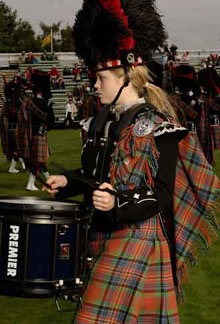 蘇格蘭短裙“遭遇”的“成長問題” [ 2007-11-21 16:29 ]
在1746年的卡倫頓一戰(zhàn)���,詹姆斯二世及其擁護者被打敗之后,蘇格蘭短裙以及其它的高地裝束都被禁止穿戴���。但是��,由于不列顛軍隊中的高地兵團仍然沿襲著這樣的裝扮����,因此蘇格蘭短裙在那一段非常時期中才得以幸存下來�。

The Original Kilt
The feileadh mor was a longer untailored garment, around five metres in length, which was gathered and then belted at the waist to provide cover for both the upper and lower body. From the waist down, the feileadh mor resembled a modern kilt while the remaining material above the waist was draped over the shoulder and pinned there.
The Kilt Evolves
The feileadh mor was simplified by disposing of its top half, leaving the belt and the skirt below. This was reputedly at the behest of an Englishman running an ironworks at Invergarry who felt his kilted employees needed a greater freedom of movement to do their work. The upper half of the big kilt evolved into the separate plaid (or sash) which is now worn at more formal events.
Proscription and Survival
Following the Jacobite defeat at Culloden in 1746, the kilt and other aspects of Highland dress were outlawed and its continued survival during these years was largely due to its adoption by Highland regiments serving with the British army.
Styles of Kilt Wear
Today most Scotsmen see kilts as formal dress or ceremonial dress. They are often worn at weddings or other formal occasions, while there are still a few people who wear them daily. Kilts are also used for parades by groups like the Scouts, and in many places kilts are seen in force at Highland games and pipe band championships as well as being worn at Scottish country dances and ceilidhs.
Kilts have become normal wear for formal occasions, for example being hired for weddings, and the kilt is being worn by anyone regardless of nationality or descent. Although a white tie style exists, the more common style of formal Highland regalia is seen in black tie.
Source: www.visitscotland.com
|